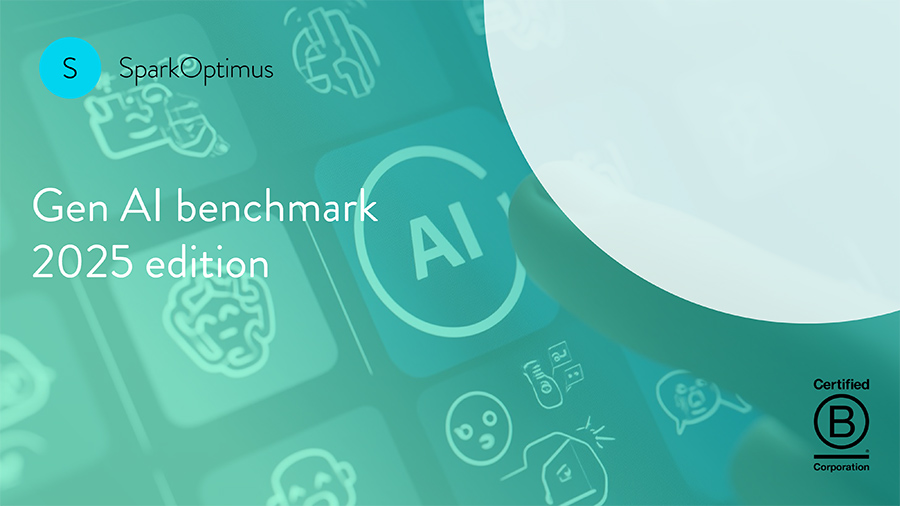生成AIはさまざまな業界で大きな影響を与えていますが、多くの組織は依然としてスケーラブルな実装に苦労しています。SparkOptimusによる50社以上を対象とした広範な調査は、この喫緊の課題に光を当て、これらのテクノロジーの可能性と実際的な実行とのバランスをとる上での熱意と不満が入り混じった状況を明らかにしています。
AI導入に向けた競争
企業がAI、そしてより高度なジェネレーティブAIの導入に向けてしのぎを削っているのは周知の事実です。効率向上と実用的な洞察という約束は、非常に魅力的です。効果的に統合されれば、これらのツールはワークフローを変革し、大きな付加価値を生み出すことができます。
最新の「Gen AI Benchmark」レポートによると、2025年に向けたパイロットプロジェクトは進展しており、企業はより明確な目標を設定し、初期のユースケースを拡大しています。ジェネレーティブAIを効果的に活用することは、今日の市場で競争力を維持するために不可欠になりつつあります。
導入率の成長
調査によると、回答者の驚くべき92%が現在、生成AIを利用しており、昨年の60%から明確な飛躍です。この急増は、組織構造へのスマートな統合の必要性が高まっていることを浮き彫りにしています。興味深いことに、59%が月に数回生成AIを使用する一方、25%は週に複数回活用しています。
生成AIのための戦略的フレームワーク
調査対象企業の4分の3は、Generative AIの実装を導くための戦略的フレームワークを開発しており、前年のわずか40%から増加しています。特に、AI実装のためのスタンドアロン戦略を持つ企業の数も、昨年から大幅に増加しています。
正式なデータ戦略の重要性
確固たるデータ戦略を確立することは、単なるアイデアから生産的なパイロットプロジェクトへの移行にとって非常に重要です。調査によると、体系的なデータ戦略を持つ企業は、ユースケースのコンセプトから実装への移行の成功率が191%向上したと報告されています。
この進捗にもかかわらず、課題はたくさんあります。驚くべきことに、企業の45%が依然として非構造化データを扱っており、信頼性に欠ける結果につながっています。さらに、60%がこのデータを最新の状態に保つために必要なツールを欠いており、それが多くの場合、新しいテクノロジーの統合の頭痛の種となっています。
実装における課題の特定と克服
生成AIの導入における進歩にもかかわらず、これらの技術を日々の業務に統合することは、多くの組織にとって困難であることがわかっています。多くの従業員が、生成AIを効果的に活用するためのスキル不足を訴えています。驚くべきことに、調査対象となった従業員のわずか20%しか適切なスキルアップを受けていません。このスキルアップの不足が、広範な導入の取り組みを停滞させており、包括的なトレーニングプログラムの必要性を強調しています。
回答者の約 60.1% が自身のスキルを不十分と評価しており、これらのツールを最大限に活用するためのガイダンスが強く求められていることを示しています。新たに導入された EU AI 法の AI リテラシーの柱は、企業が従業員全体のスキル向上に注力することの緊急性を強調しています。
明確な目標と指標の定義
今回の調査からさらに明らかになったのは、企業のわずか27%が、定量化可能な目標をもってGenerative AI戦略をサポートしているということです。明確な目標がないと、進捗や成果を効果的に測定することが難しくなります。さらに、多くのGenerative AIパイロットは遅れており、具体的な成果が出ないまま3ヶ月以上かかることが多く、実用的な実世界アプリケーションへの移行を妨げています。
SparkOptimusのアソシエイトパートナーであるMatti van Engelen氏によると、Generative AIの意欲的な導入努力は、共通の障害によって妨げられています。これには、プロジェクトの所有権の分断、基幹業務プロセスへの統合の不十分さ、価値を測定するための不明確な指標などが含まれます。その結果、多くのAIイニシアチブは孤立したままであり、組織全体に浸透するのではなく、孤立したチームへの影響を限定しています。
今後の展望:物流における生成AIの未来
生成AIの状況が進化し続けるにつれて、物流への影響は見過ごせません。企業は、進行中の変化を受け入れ、それに応じて戦略を適応させる必要があります。たとえば、タイムリーで効率的な商品の移動は、高度なAI分析とデータ駆動型の意思決定プロセスに大きく依存しています。組織がGetTransport.comのようなプラットフォームと提携することで、物流を合理化し、貨物管理を強化し、商品の迅速な配送を保証できます。これは、競争上の優位性を維持するための重要な要素です。
結論:ロジスティクスを強化するために生成AIを取り入れる
要するに、生成AIの導入における進歩は有望である一方で、大規模な効果的な実装という課題は依然として大きいままです。SparkOptimusの調査から得られた洞察は、これらの技術の可能性を真に活用するために、包括的な戦略、スキルアップの機会、測定可能な目標の必要性が高まっていることを強調しています。GetTransport.comのような組織は、物流の課題を乗り越えるための関連性の高い協力者として登場し、家庭やオフィス移転、貨物配送、大型アイテムの輸送に合わせた、信頼できるグローバルな貨物輸送ソリューションを提供しています。
ジェネレーティブAIのニュアンスを発見し、それを物流に統合することで、より効率的なオペレーションと効率的な商品の輸送への道が開かれます。潮目が変わるのを待つのではなく、今後の課題と機会を検討してください。効率的で手頃な価格の物流ソリューションについては、今すぐGetTransport.comで輸送手段をご予約ください。

 ジェネレーティブAI導入のハードルと物流への影響を探る">
ジェネレーティブAI導入のハードルと物流への影響を探る">